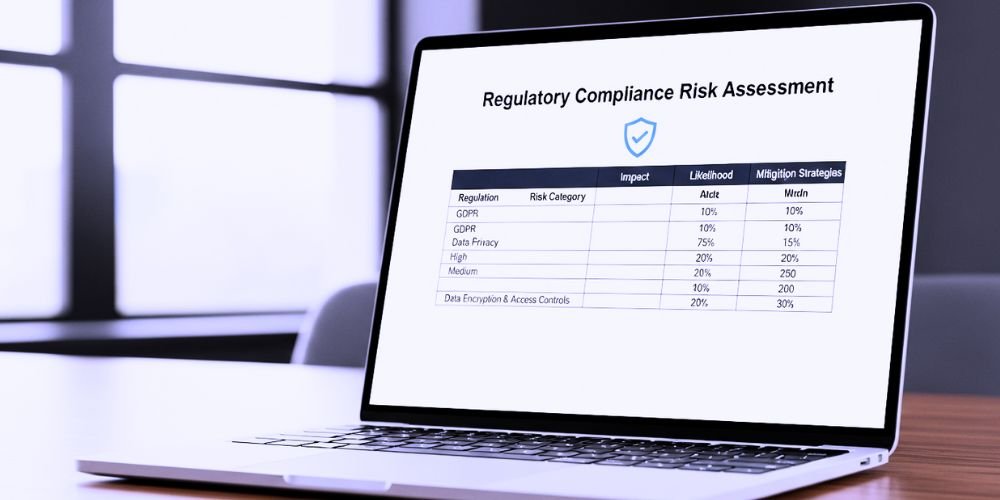In today’s complex and highly regulated business environment, organizations face numerous legal and regulatory requirements that govern their operations. Failure to comply with these regulations can result in severe consequences, including financial penalties, reputational damage, and legal liabilities. This article delves into the significance of regulatory compliance risk, its key components, and strategies for effective risk management.
Understanding Regulatory Compliance Risk
Regulatory compliance risk refers to an organization’s potential exposure due to non-compliance with laws, regulations, industry standards, and internal policies that govern its operations. It encompasses the risks of failure to meet legal obligations, maintain ethical practices, and adhere to industry best practices. Regulatory compliance risk is prevalent across various sectors and can vary based on regional, sector-specific, and organizational factors. Regulatory compliance risk management is crucial in helping organizations understand, mitigate, and navigate the ever-evolving landscape of regulatory requirements.
Key Components of Regulatory Compliance Risk
Ensuring regulatory compliance is a critical aspect of any business operation. It helps maintain the industry’s integrity, protect consumers, and avoid any legal repercussions.
Laws and Regulations
Regulatory compliance risk stems from the extensive web of laws and regulations organizations must adhere to. These include industry-specific rules, labor laws, data privacy, and protection regulations, anti-corruption laws, environmental regulations, financial reporting requirements, and consumer protection laws. Understanding and complying with these regulations is vital to mitigate compliance risk.
Internal Policies and Procedures
Organizations often develop internal policies and procedures to ensure compliance with external regulations and industry standards. These policies govern codes of conduct, employee behavior, data handling, financial controls, and risk management practices. Failure to adhere to internal guidelines can lead to compliance breaches and expose the organization to regulatory risks.
Stakeholder Expectations
Stakeholders, including customers, investors, employees, and regulatory bodies, have heightened expectations regarding ethical practices, transparency, and compliance. Non-compliance can damage an organization’s reputation, erode stakeholder trust, and result in negative financial and operational consequences. Meeting stakeholder expectations is crucial to managing regulatory compliance risk effectively.
Strategies for Effective Regulatory Compliance Risk Management
To effectively manage regulatory compliance risk, businesses must adopt strategies that prioritize identifying potential hazards, assessing their impact, and implementing measures to prevent or address them.
Establish a Compliance Program
Developing a comprehensive compliance program is essential for managing regulatory compliance risk. This program should outline the organization’s commitment to compliance, define responsibilities, and establish processes for monitoring, reporting, and addressing compliance issues. It should incorporate regular training programs to educate employees on regulatory requirements and expectations.
Conduct Compliance Assessments and Audits
Regular compliance assessments and audits are critical to identify and address compliance gaps and vulnerabilities. These assessments involve reviewing processes, procedures, and systems to ensure they align with regulatory requirements. By proactively identifying areas of non-compliance, organizations can take corrective measures and mitigate compliance risks.
Stay Abreast of Regulatory Changes
Monitoring and staying informed about regulatory changes is crucial to managing compliance risk. Organizations should have processes to track and interpret new or updated regulations that may impact their operations. Engaging legal counsel, subscribing to regulatory updates, and participating in industry associations can help organizations stay current with evolving requirements.
Implement Effective Controls and Governance
Establishing robust internal controls and governance mechanisms is vital for managing it. It includes implementing processes, systems, and checks to ensure regulations and internal policy adherence. Organizations should establish clear lines of responsibility, segregate duties, and enforce accountability to prevent compliance breaches.
Foster a Culture of Compliance
Promoting a culture of compliance throughout the organization is essential. It involves creating awareness, training, and instilling ethical values among employees. Organizations should encourage open communication channels for reporting potential compliance violations and ensure protection against retaliation for whistleblowers. By fostering a culture of compliance, organizations can proactively manage compliance risks.
Engage External Expertise
In complex regulatory environments, seeking external expertise can be beneficial. Engaging legal counsel, compliance consultants, or industry experts can provide useful insights and guidance on navigating specific regulatory requirements. These experts can help organizations interpret regulations, develop compliance strategies, and implement best practices.
The Benefits of Effective Regulatory Compliance Risk Management
Effective regulatory compliance risk management can bring numerous benefits to businesses. Companies can avoid costly penalties and legal consequences by implementing strategies to identify and address potential risks.
- Minimized Financial and Legal Liabilities: Effective regulatory compliance risk management reduces the likelihood of financial penalties, lawsuits, and legal liabilities. By maintaining compliance, organizations avoid costly legal disputes and reputational damage associated with non-compliance.
- Enhanced Reputation and Stakeholder Trust: Managing compliance risk fosters a positive reputation and builds stakeholder trust. Organizations that demonstrate a commitment to ethical practices, transparency, and regulatory compliance are more likely to attract customers, investors, and business partners.
- Improved Operational Efficiency: Efficient compliance processes and systems streamline operations and reduce disruptions caused by non-compliance incidents. Organizations can improve operational efficiency and mitigate potential risks by embedding compliance into organizational processes.
- Competitive Advantage: Effectively managing regulatory compliance risk provides a competitive advantage. Compliance with regulations and industry standards can differentiate an organization from its competitors, instilling confidence in customers and stakeholders.
Conclusion
Regulatory compliance risk poses significant challenges for organizations in today’s complex business landscape. Understanding the regulatory requirements, establishing robust compliance programs, and implementing effective risk management strategies are crucial for mitigating compliance risk. By proactively managing compliance, organizations minimize legal and financial liabilities, enhance their reputation, improve operational efficiency, and gain a competitive edge. Embracing a culture of compliance and staying abreast of regulatory changes enable organizations to navigate the regulatory landscape successfully and ensure adherence to ethical practices.













